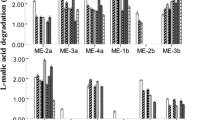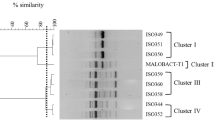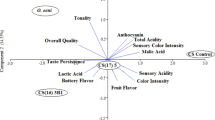Abstract
Malolactic fermentation (MLF), mainly carried out by lactic acid bacterium, is of immense importance in winemaking allowing for improvement of microbiological stability and organoleptic characteristics of wine. However, it is difficult to address the problems of decoloration and loss of taste along with MLF induced by traditional starter culture. To further the aim at realizing a controlled and efficient MLF process, mutant of Oenococcus oeni strains after ultraviolet irradiation was selected to enhance quality of MLF. The treated strains with a lethality rate of 80–90 % were preliminarily screened, and then were secondly screened by evaluating their sensory and fermentation properties, by which O. oeni C10-1 were successfully screened. The malolactic conversion rate of O. oeni C10-1 is up to 38.81 %, which is remarkably increased when compared to original strains. Pivotally, wine fermented by O. oeni C10-1 demonstrated the highest color density of 9.240 and got the score of 5.95 in softness index, suggesting a remission of decoloration phenomenon and improved mouth feeling of wine. In all, these make it highly valuable for industrial application.
Graphical Abstract




Similar content being viewed by others
References
Coucheney F, Desroche N, Bou M, Tourdot-Marechal R, Dulau L, Guzzo J (2005) A new approach for selection of Oenococcus oeni strains in order to produce malolactic starters. Int J Food Microbiol 105(3):463–470. doi:10.1016/j.ijfoodmicro.2005.04.023
Ruiz P, Izquierdo PM, Seseña S, Palop ML (2010) Analysis of lactic acid bacteria populations during spontaneous malolactic fermentation of tempranillo wines at five wineries during two consecutive vintages. Food Control 21(1):70–75. doi:10.1016/j.foodcont.2009.04.002
Gao J, Vasantha Rupasinghe HP, Pitts NL (2013) Characterisation of malolactic conversion by Oenococcus oeni to reduce the acidity of apple juice. Int J Food Sci Technol 48(5):1018–1027. doi:10.1111/ijfs.12056
Ruiz P, Izquierdo PM, Sesena S, Garcia E, Palop ML (2012) Malolactic fermentation and secondary metabolite production by Oenococcus oeni strains in low pH wines. J Food Sci 77(10):M579–M585. doi:10.1111/j.1750-3841.2012.02895.x
Lasik M (2013) The application of malolactic fermentation process to create good-quality grape wine produced in cool-climate countries: a review. Eur Food Res Technol 237(6):843–850. doi:10.1007/s00217-013-2083-x
Richelieu JCNaM (1999) Control of flavor development in wine during and after malolactic fermentation by Oenococcus oeni. Appl Environ Microbiol 65(2):740–745
Romfio ICMVS (1994) Effect of ethanol and fatty acids on malolactic activity of Leuconostoc oenos. Appl Microbiol Biotechnol 42:391–395
Rodriguez-Nogales JM, Vila-Crespo J, Fernandez-Fernandez E (2013) Immobilization of Oenococcus oeni in lentikats(R) to develop malolactic fermentation in wines. Prog Biotechnol 29(1):60–65. doi:10.1002/btpr.1651
Boido E, Medina K, Farina L, Carrau F, Versini G, Dellacassa E (2009) The effect of bacterial strain and aging on the secondary volatile metabolites produced during malolactic fermentation of tannat red wine. J Agric Food Chem 57(14):6271–6278. doi:10.1021/jf900941y
Gao C, Fleet G (1994) The degradation of malic acid by high density cell suspensions of Leuconostoc oenos. J Appl Microbiol 76(6):632–637
Esti M, Volpe G, Micheli L, Delibato E, Compagnone D, Moscone D, Palleschi G (2004) Electrochemical biosensors for monitoring malolactic fermentation in red wine using two strains of Oenococcus oeni. Anal Chim Acta 513(1):357–364. doi:10.1016/j.aca.2003.12.011
López I, Tenorio C, Zarazaga M, Dizy M, Torres C, Ruiz-Larrea F (2007) Evidence of mixed wild populations of Oenococcus oeni strains during wine spontaneous malolactic fermentations. Eur Food Res Technol 226(1–2):215–223. doi:10.1007/s00217-006-0529-0
Genisheva Z, Mussatto SI, Oliveira JM, Teixeira JA (2013) Malolactic fermentation of wines with immobilised lactic acid bacteria—influence of concentration, type of support material and storage conditions. Food Chem 138(2–3):1510–1514. doi:10.1016/j.foodchem.2012.11.058
Agouridis N, Kopsahelis N, Plessas S, Koutinas AA, Kanellaki M (2008) Oenococcus oeni cells immobilized on delignified cellulosic material for malolactic fermentation of wine. Bioresour Technol 99(18):9017–9020. doi:10.1016/j.biortech.2008.04.026
Wilska-Jeszka J (2002) 9 Food Colorants. Chemical and functional properties of food components: 205
Liu SQ, Pilone GJ (2000) An overview of formation and roles of acetaldehyde in winemaking with emphasis on microbiological implications. Int J Food Sci Technol 35(1):49–61
Akcil A (2004) Potential bioleaching developments towards commercial reality: Turkish metal mining’s future. Miner Eng 17(3):477–480. doi:10.1016/j.mineng.2003.10.016
Kosseva M, Kennedy J (2004) Encapsulated lactic acid bacteria for control of malolactic fermentation in wine. Artif Cells Blood Substit Biotechnol 32(1):55–65
Dong Y, Lin H, Wang H, Mo X, Fu K, Wen H (2011) Effects of ultraviolet irradiation on bacteria mutation and bioleaching of low-grade copper tailings. Miner Eng 24(8):870–875. doi:10.1016/j.mineng.2011.03.020
Hernández-Orte P, Lapeña A, Escudero A, Astrain J, Baron C, Pardo I, Polo L, Ferrer S, Cacho J, Ferreira V (2009) Effect of micro-oxygenation on the evolution of aromatic compounds in wines: malolactic fermentation and ageing in wood. LWT Food Sci Technol 42(1):391–401
Hernández B, Sáenz C, de la Hoz JF, Alberdi C, Alfonso S, Diñeiro JM (2009) Assessing the color of red wine like a taster’s eye. Color Res Appl 34(2):153–162
Xi LIN, Zhao-lin LU, Yong-hong Y (2011) Optimization of malo-lactic fermentation parameters of cider after the addition of leuconostoc mesenteroides WZ30-2. Liquor Mak Sci Technol 3:17–23
Xu Y, Zhao G, Li HPaJ (2005) Effects of inhibitory environmental factors on growth of Oenococcus oeni CCSYU2068 for malolactic fermentation of cider production. Inst Brew Distill 111:223–228
Lee JE, Hwang GS, Lee CH, Hong YS (2009) Metabolomics reveals alterations in both primary and secondary metabolites by wine bacteria. J Agric Food Chem 57(22):10772–10783. doi:10.1021/jf9028442
Pramateftaki PV, Metafa M, Karapetrou G, Marmaras G (2012) Assessment of the genetic polymorphism and biogenic amine production of indigenous Oenococcus oeni strains isolated from Greek red wines. Food Microbiol 29(1):113–120. doi:10.1016/j.fm.2011.09.007
Nielsen JC, Richelieu M (1999) Control of flavor development in wine during and after malolactic fermentation by Oenococcus oeni. Appl Environ Microbiol 65(2):740–745
Zhengui MA, Weichao MA, Jianping PU, Jianping A (2011) UV mutagenesis in efficient degradation strains of potato pulp and fermentation. China Brew 1:123–126
Shi-chang Li, Zhao-yang Zhu, Min W (2009) Screening of high-yield L(+)-Lactic acid strains by microwave irradiation mutagen. Acta Laser Biol Sinica 18:647–651
Somers TC, Evans ME (1974) Wine quality: correlations with colour density and anthocyanin equilibria in a group of young red wines. J Sci Food Agric 25(11):1369–1379
Chris Somers T, Evans ME (1977) Spectral evaluation of young red wines: anthocyanin equilibria, total phenolics, free and molecular SO2, “chemical age”. J Sci Food Agric 28(3):279–287
Acknowledgments
This work was financially supported by a research grant from the Chinese Ministry of Education Doctor Degree (20101333120011), grants from the Hebei Province Natural Science Fund (C2011203137, 11965152D), and a Chinese postdoctoral grant (480013).
Conflict of interest
None.
Compliance with Ethics Requirements
This article does not contain any studies with human or animal subjects.
Author information
Authors and Affiliations
Corresponding author
Additional information
N. Li and J. Duan have contributed equally to this paper.
Electronic supplementary material
Below is the link to the electronic supplementary material.
Rights and permissions
About this article
Cite this article
Li, N., Duan, J., Gao, D. et al. Mutation and selection of Oenococcus oeni for controlling wine malolactic fermentation. Eur Food Res Technol 240, 93–100 (2015). https://doi.org/10.1007/s00217-014-2310-0
Received:
Revised:
Accepted:
Published:
Issue Date:
DOI: https://doi.org/10.1007/s00217-014-2310-0




